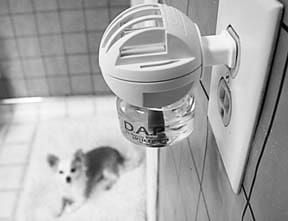Early this winter, I decided to test the new behavior modification product on the market. It’s essentially an atomizer, similar to room deodorizers that are plugged into electrical outlets, but this product emits a substance dubbed “dog appeasing pheromone” (“DAP” for short) that is supposed to reduce any dog’s stress. The product is sold as the “Comfort ZoneTM Canine Behavior Modification Plug-In,” under the Farnam Pet Products banner.
According to its maker, DAP is supposed to mimic a natural stress-reducing hormone produced by mother dogs while nursing their puppies. It purportedly stops or reduces stress-related barking, urination and defecation, whimpering and whining, anxiety, fear, chewing, and other stress-related behaviors.
One plug-in unit is supposed to dispense enough of the DAP substance to “cover” 500-650 square feet for about four weeks. It has been used in Europe for some time, reportedly with positive results. Recently approved for use in this country, it is reputedly safe for dogs and puppies, and is not supposed to affect humans. Another variety, for stressed-out cats, is sold as “Feliway.” Both are available from pet supply catalogs, ranging in price from $20 – $25 per unit, with refills costing $10 – $15.
Putting DAP to the test
I wondered if the Comfort Zone would help my Scottish Terrier, Dubhy, who gets over-aroused in the presence of some dogs, and who had gotten into a couple of scuffles over his food bowl with my Kelpie, Katie. I also wondered if it would have any effect on the other three dogs in my home.
I plugged in the diffuser unit in my office, where the dogs and I spend our daytime hours. Within three weeks I noticed a marked reduction in Dubhy’s resource-guarding. Katie could watch him eat, and then lick his bowl clean when he was done, with no apparent tension on the Scottie’s part. In the past, he had guarded even his empty bowl.
I also noticed a reduction in his arousal around other dogs at my training center. In addition, he does less arousal barking in the backyard, and comes to me more readily when I call him away from stimuli that cause the arousal barking.
It also seemed to help my Cattle Dog-mix’s thunder phobia. We already give Tucker melatonin for storms, which improves his behavior from panicked to merely tense. At first, I thought the DAP wasn’t affecting Tucker’s storm-related anxiety. For weeks, there appeared to be no change in his behavior when storms occurred.
But about six weeks after I introduced the Comfort Zone, while working in my office during an unusually violent storm, I looked down to see Tucker, curled up, sound asleep on the dog bed under my desk. That behavior has continued since; he seeks out the spot under my desk during storms, but no longer trembles or shows the other signs of serious storm phobia that he used to display.
The product has not, however, reduced Katie’s typical herding dog’s control-freak behavior that compels her to stop our other dogs from playing in the house. Two out of three’s not bad!
Positive reports
A recent survey of trainers and dog owners on several e-mail lists found similarly positive results among a large percentage of Comfort Zone users. Here are some of their comments:
“I have been using a DAP diffuser for the last two months. My Dalmatian was beginning to show mild signs of anxiety/stress when we left him alone. The very first time I used it I found a remarkable change in his demeanor when we came home. We also continue to use management, and have had no further problems with him getting stressed when we leave.”
-Patricia Ellis
Milwaukee, Wisconsin
“In a nutshell: I think it’s a great aid to a program of management. Some recent successes [I’ve witnessed] include a pair of Wheaton Terriers who were extremely reactive about the door; a Jack Russell Terrier adjusting to a baby; and a dog who had been on medication for years. Coupled with about six months of effort on his owners’ part and a DAP diffuser, the latter dog is now on medication only for ‘hard times’ like the Fourth of July, Halloween, and New Year’s Eve.”
-Elaine Allison, CPDT
Canine’s Best Behavior
Los Angeles, California
“I have had very good results with DAP for a variety of anxiety-related problems in dogs (noise phobia, separation anxiety, aggression, fearful behaviors.”
-Lore I. Haug, DVM, MS, DACVB
College Station, Texas
“We started using the Comfort Zone a few months ago for two of our dogs: Trixie, a Giant Schnauzer with mild thunderstorm phobia; and Lucas, a Lab/Pit Bull mix, with severe thunderstorm phobia and mild separation anxiety. In less than a week, Trixie and Lucas were much calmer.
In addition, all of the other things we were using to try to modify Lucas’ behavior began to work! We were already giving him herbs for anxiety, vitamin supplements, acupuncture, massage, and more. Even with all that, his storm-related and separation anxiety was causing grand mal seizures.
Today, Lucas is doing great. He hasn’t had a seizure in two months. He has learned how to play ball and play with our other dogs, is relaxed when we leave home, and even tolerated a recent thunderstorm with very little anxiety. We are very pleased with Comfort Zone.”
-Megan Rollins
The Pawsative Connection
Chattanooga, Tennessee
“I have two clients who have used the Comfort Zone with great results. One has a bitch in false pregnancy, who started having aggression issues. The owner put the DAP unit at the gate she uses to divide the dogs, and reports that they no longer display any barrier aggression.
The other client has a dog who would drool in excess while crated. About two weeks after she started using the Comfort Zone, the dog stopped drooling when crated.”
-Cheri Spaulding, Rock Nest Kennels
St. Johnsbury Center, Vermont
Negative marks
Lest you get your hopes up that the Holy Grail of dog behavior modification has been discovered, please note that it doesn’t appear to work for all dogs and behaviors.
Like my own personal experience with Katie’s incessant herding dog behavior, a number of owners and trainers also reported a disappointing lack of behavior change after introducing the Comfort Zone. Here are some of their comments:
“I tried using DAP in the house to see if it might help the foster dogs coming in, and perhaps ease the resident dogs’ stress and adjustment that always accompanies a new dog in the house. I did not observe any effect on behavior, and did not purchase any more after the second refill.”
-Vicki Magnus
Waldorf, Maryland
“I tried Comfort Zone for both a mildly whiny dog during separation and for a hyperkinetic dog and saw no effect whatsoever. I was disappointed, because the comments I had read on some training lists were so positive. My conclusion was that it had no measurable effects. Possibly my test dogs ages (seven and up) may have been a factor.
-Carole Lawson
Classic Academy of Canine Learning Cleveland, Ohio
(Author’s note: Tucker, our Cattle Dog mix whose thunder phobia has eased significantly, is nine years old.)
“I advised two of my clients to try Comfort Zone. One client has a German Shorthaired Pointer who is very ‘busy,’ always in movement, and doesn’t settle until about 8pm. We tried Comfort Zone on this dog for over a month with no results at all. I was very disappointed. The second dog is a Beagle/Jack Russell mix with severe separation anxiety. We tried Comfort Zone for at least two months and it actually seemed to make the dog worse; greater anxiety and more destruction noticed. Again, disappointed.
-Bernadette Ball
Strickly Dogs
Cincinnati, Ohio
Making matters worse?
The trainer quoted above was not the only one who noted a deterioration of a dog’s behavior when exposed to DAP. One of my good friends has a mature yellow Labrador Retriever with an insatiable desire to eat paper, leather, and other inappropriate objects. We eagerly subjected her to Comfort Zone, only to have her pica behavior worsen.
While clearly not a panacea for all dogs, DAP seems to have a positive effect on enough dogs to make it a worthwhile adjunct to a behavior modification program. Of 42 responses to our survey question, 64.3 percent (27) reported positive results; 30.9 percent (13) reported no observable behavior change; and 4.8 percent (2) reported negative results. Not a scientific study, to be sure, but fairly convincing anecdotal evidence.
One has to wonder about the two dogs whose behavior deteriorated in the presence of DAP. Perhaps a negative association with those early nursing pheromones? Who knows? Maybe they had “Mommy Dearest” type puppyhoods!







After reading this article I looked high and low to purchase one for my dog in hopes of alleviating some of her recent anxiety but could only find diffusers for cats. I called the company and was told the dog diffuser had been discontinued. I asked why, and was told “that was proprietary information”. Thought about just getting the spray but now I think I’ll go with another company all together…
Works wonders for my pit bull mix with anxiety and resource guarding issues. In fact, if it runs out before I notice, her change in behavior is significant.
We have a German Short Hair /Lab mix with SEVERE separation anxiety. We also have a lab /Husky mix with no anxiety issues, but we keep their kennels in the same room when we are gone. Is there an issue with using the DAP with the dog with no issues?